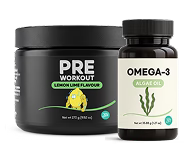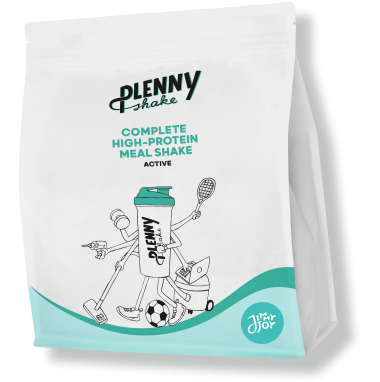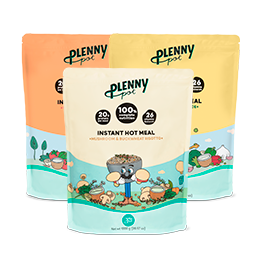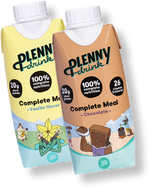Risks of saturated fats
The role of saturated fats in health has been widely analyzed, where studies have shown that consuming excessive amounts of these fats can raise cholesterol levels and, in the long term, increase the risk of heart disease by promoting blood clotting. Therefore, it is important to limit the amounts consumed per day and opt for unsaturated forms of fat. Other fats associated with health risks are trans fats.
Trans fats
Trans fats are created through a chemical process called hydrogenation. Hydrogenation adds hydrogen to healthy liquid oils. This increases their stability and makes them more solid. It also protects them from going rancid, which is why trans fats tend to be used to extend the expiration dates of processed foods. Studies have found that eating foods high in trans fats can increase levels of harmful cholesterol in our blood, as well as cause inflammation, which is linked to an increased risk of heart disease. [5, 6]
Unsaturated fats
Unsaturated fats are known as "good fats." They are found primarily in plant-derived products such as sunflower oil, flaxseed oil, avocados, nuts, and whole grains. Unsaturated fats are liquid at room temperature if they are not hidden within a food because they have both single and double bonds in their structure. [2]
Monounsaturated fats
This type of fat contains only one double bond in its structure. The main food sources you can get them from are olive oil, avocado, peanut oil, sunflower oil, and canola oil. They are recommended over saturated fats as they are believed to lower bad cholesterol. [7]
Omega-3 fatty acid
Omega-3s play an active role in the maintenance and development of the retina (eyes), skin, and brain. Fatty acids go through several stages before becoming an omega-3 fatty acid. The 3 most important omega-3 precursors are: alpha-linolenic acid (ALA), docosahexaenoic acid (DHA), and eicosapentaenoic acid (EPA). [8]
Alpha Linolenic Acid (ALA)
Linolenic acid (ALA) is the first precursor of omega-3 fatty acids. It is commonly found in seeds and vegetable oils, such as flaxseed, sunflower oil, and algae. The human body converts ALA into eicosapentaenoic acid (EPA). However, the absorption of direct EPA into the body is much more efficient than when it is obtained from ALA first. [8, 9]
Eicosapentaenoic acid (EPA)
Eicosapentaenoic acid (EPA) is commonly found in marine creatures such as fatty fish. Fish eat algae, which contains ALA. It then converts the ALA into EPA, which is why fish provide a direct source of EPA when consumed by other animals or humans. Your body can also naturally convert ALA into EPA. Studies have shown that taking large doses of EPA (more than 2.0 to 4.0 g/day) can reduce inflammation in the body. [8, 9]
Docosahexaenoic acid (DHA)
Docosahexaenoic acid (DHA) is converted from EPA. Similar to EPA, it can also be obtained through fish oils and algae. It is the most common omega-3 fatty acid present in the brain and retina. DHA is also transmitted through breast milk. Some studies claim that this makes it an important nutrient during pregnancy and breastfeeding. [8, 9]
Omega-6 fatty acid
Omega-6 fatty acids have several precursor stages. The main precursor of the omega-6 family is called linoleic acid (LA), which is found in vegetable oils. Eventually, LA is converted to arachidonic acid (AA), which helps with proper skin and hair growth. It also has anti-inflammatory effects. Omega-6 fatty acids are much more common than omega-3 fatty acids and are found in the vast majority of foods we eat: whole grain bread, wheat, most vegetable oils, and cereals. [9, 10]
Omega-9 fatty acid
Omega-9 is a non-essential fatty acid. Our body is able to create omega-9, for example, from the unsaturated fats we eat. This fatty acid increases our energy levels and brain function. However, more research is still needed to understand the functions of this fatty acid more precisely. [9, 11]
Protein
Protein is one of the main components of the human body. It is necessary for the growth, restoration and maintenance of body cells, tissues, bones, skin and muscles.
No wonder it's called protein, which means: of primary importance. Most people associate protein with muscle building, but did you know that your muscles work non-stop, even when you sleep? That's why your body needs a constant supply of protein. Proteins are made up of amino acids. But what exactly are they? [1, 9]
Amino acids
Amino acids are the main building blocks of proteins. A protein can have fewer than 100 to more than 30,000 amino acids, and they all have the same structure: a central carbon atom with a hydrogen atom, an amino group, an acid group, and a side group that can vary. The variation in the side group determines the type of amino acid. They are classified as essential, conditionally essential, or nonessential based on several factors. [1, 9]
AA essential
Essential amino acids are AAs that the human body is unable to produce or cannot produce sufficient amounts of. Therefore, it is crucial to include them in your diet. Foods rich in amino acids are: eggs, soy protein, buckwheat, white fish, chicken, meat, and seeds (hemp, pumpkin, chia, sesame). There are nine essential amino acids: Histidine, Isoleucine, Leucine, Valine, Lysine, Methionine, Phenylalanine, Threonine, and Tryptophan. [9]
Histidine
Histidine provides structure to hemoglobin. Hemoglobin is the protein in the blood responsible for transporting oxygen to most of our cells and tissues. It also controls the immune response in your skin. [9]
Isoleucine, Leucine and Valine
This trio is called “branched chain amino acids” (BCAAs). They are directly and strongly involved in muscle growth by enhancing the genetic signaling pathway called mTOR. In addition, these AAs are also involved in the uptake of glutamine and alanine, and important elements such as nitrogen and carbon. [9, 12, 13]
Lysine
Lysine controls the production of nitric oxide. Nitric oxide is a gas that causes our blood vessels to widen, which supports the transport of nutrients and other important molecules through our body. [9]
Methionine
Methionine contains sulfur, which is a molecule that protects your tissues, modifies DNA, and keeps your cells functioning properly. It also balances the production of nitric oxide and substances that protect your cells from environmental stresses, such as the risk of infections, lack of food, water, or oxygen. Methionine is involved in the creation of the non-essential amino acid cysteine, which is another important sulfur-containing AA for your body. [14, 15]
Phenylalanine
Phenylalanine is key to the activation of nitric oxide (the gas that widens blood vessels), the production of tyrosine (which improves attention and concentration) and the neurological development of brain cells. [9]
Threonine
Threonine produces important proteins that help your immune system stay strong and benefit your gut health. This AA is also necessary for the development of the non-essential amino acid called glycine. [9]
Tryptophan
Tryptophan limits the production of inflammatory cells called cytokines. They put the body into flight mode, which is an unwanted effect when you don't actually have to run away from a pack of wolves. It also has antioxidant properties, meaning it protects our cells from the effects of free radicals. These free radicals cause aging, damage tissue, and probably cause some diseases [9, 16]
Non-essential AA
Non-essential amino acids are AAs that the body is able to produce on its own. It creates them from carbohydrates, fats, and nitrogen-containing foods. The 11 non-essential amino acids are alanine, arginine, asparagine, aspartic acid, cysteine, glutamic acid, glutamine, glycine, proline, serine, and tyrosine. [9]
Alanine
Alanine provides energy for both our muscles and our brain. It acts as a buffer in our muscles, making them work better. This buffering activity involves regulating the acidity level (pH) in the muscles which is influenced by the different cycles our body works in during the day. Alanine also helps with the creation of simple sugar in our liver. [17, 18]
Arginine
Arginine is involved in wound healing and hormone production. It is also involved in ammonia detoxification. Ammonia is a waste product generated after protein digestion. [9, 13]
Asparagine
Asparagine is involved in controlling cellular functions in the brain. It is also responsible for detoxifying ammonia. In addition, it regulates genetic signals that make our immune and nervous systems function properly. [9]
Aspartic acid
Aspartic acid plays a role in the normal functioning of the nervous system. It also helps in the production and release of hormones. [9]
Cysteine
Cysteine moves sulfur around the body. Sulfur helps with wound healing and the breakdown of substances outside the body (such as food and medications). Cysteine also has an active role as an antioxidant. [19]
Glutamine
Glutamine is the primary amino acid involved in muscle growth. It is often taken as a post-workout supplement to fuel exhausted cells and prevent them from dying. Additionally, this amino acid improves gene expression, immune function, and provides energy to absorptive cells in the small intestine. [13]
Glutamic acid
Glutamic acid is one of the main neurotransmitters in the brain. As you can see from its name, it is involved in the production of glutamine. Along with glutamine, it also maintains the nitrogen balance in our body. [20]
Glycine
Glycine improves calcium entry into our cells. It is also involved in the production of DNA units. In addition, it regulates the development of signaling molecules and heme proteins (which are involved in oxygen transport in our tissues and organs). [9]
Proline
Proline contributes to the formation of collagen. This is the main structural unit of tissues that connects, supports or separates our organs. Proline also helps eliminate pathogens (bacteria and viruses) by strengthening the immune system. [21]
Serine
Serine contributes to the production of essential DNA units and the amino acid tryptophan. It also activates important receptors in our brain, thereby improving neurotransmitter signaling that maintains communication within the brain. [9]
Tyrosine
Tyrosine has most of the same functions as other amino acids: it promotes protein production, is anti-inflammatory, and has antioxidant capabilities. [9, 13]
AA conditionally essential
Sometimes a non-essential amino acid can become conditionally essential. For example, when the diet does not provide sufficient amounts of the nutrients needed to form them, or when you are under a certain disease and the conversion of one amino acid to another cannot be fully carried out.
In other words, when the need for AA exceeds the body's ability to produce it. [1, 22]
Carbohydrates
Carbohydrate is the collective name for sugars, starches, and fibers that can be found in fruits, grains, vegetables, and dairy products. Carbohydrates are your body's main energy provider. They also keep your metabolism running and your blood sugar levels stable. Carbohydrates are divided between simple carbohydrates (monosaccharides and disaccharides) and complex carbohydrates (polysaccharides). [1, 23]
Monosaccharides (simple carbohydrates)
Monosaccharides are the most basic form of carbohydrates and the simplest form of sugar. They contain only one sugar unit. Generally speaking, this type of carbohydrate is quickly absorbed by the body because it has such a simple structure. The three different monosaccharides are glucose, fructose, and galactose. They all have the same type and number of atoms (carbon, hydrogen, and oxygen) but differ in their arrangement. This gives each a different level of sweetness. [1, 24]
Glucose
Glucose, meaning "sweet" in Greek, is the most common monosaccharide. Our body converts 100% of the carbohydrates we eat into glucose, which serves as our body's essential energy source. When it travels through our bloodstream to our cells, it is called blood sugar, and the hormone insulin is responsible for moving blood sugar into our cells. People who have diabetes have excessive amounts of glucose in their blood because their insulin balance is off. [25]
Fructose
Fructose comes naturally from fruits and vegetables. Because of its structure, it is known to be the sweetest sugar of all. Fructose has the ability to stimulate our taste buds twice as much as glucose. Therefore, you would need less of it for sweetening purposes. [1, 9]
Galactose
Galactose is the main carbohydrate component in milk and dairy products. It is less sweet than glucose and fructose, but is still fairly close to glucose in structure and taste. It is an important component of our central nervous system, hence its nickname "brain sugar."[9]
Disaccharides
Disaccharides are a slightly more complex form of carbohydrates, but they are still easy to digest. They contain two sugar units, as they are made when two monosaccharides pair up. For example, if you combine glucose with galactose, you get the milk sugar lactose. As you can see, the structure of disaccharides is a bit more complicated than that of monosaccharides. Therefore, it takes longer for our body to digest and absorb them. [1, 24]
Maltose
Maltose consists of two glucose units linked together. It occurs naturally during the digestion of carbohydrates in your body. Maltose can also be formed during the fermentation process of alcohol, for example during the production of beer or wine. It is the least sweet of all sugars. [9]
Saccharose
Sucrose, also known as table sugar, is formed by combining fructose and glucose. Since it contains fructose (which is already really sweet), you can imagine that this is the sweetest disaccharide out there. Non-caloric sweeteners like sucralose are produced from sucrose to be used as sugar substitutes. This is 600 times sweeter than regular sucrose. Several studies claim that sucralose is poorly absorbed into the body and therefore most of it will be eliminated without influencing blood sugar levels. [26]
Polysaccharides (complex carbohydrates).
Polysaccharides are the most complex form of saccharides and take the longest to be broken down by the body. They are formed when many saccharides are combined. For example, when many glucose molecules are connected, they form glycogen, a polysaccharide that stores energy in the muscles and liver for future use. Fibers are another common polysaccharide. [1, 24]
Fiber
Fiber is one of the main components of plant cells and grains, making it a vital and strong nutrient. So strong that it can withstand the early stage of digestion in our body. This allows it to reach our intestines, where it becomes dinner for our hungry gut bacteria. Fiber slows the rate at which sugar is absorbed into the bloodstream, which reduces the risk of heart disease and diabetes. They can also improve the movement of food through our digestive system depending on whether it is soluble or insoluble. [27, 28]
Soluble fiber
Soluble fibers can dissolve in water and turn into a gel during digestion. This makes our stool firmer and more regular. It also binds to glucose (sugar), which makes it absorbed much more slowly. Additionally, soluble fiber is prebiotic, meaning it increases the population of good bacteria in our intestines. When soluble fibers reach our colon (the last bit of the large intestine), a signal is released that tells our brain to stop eating. Therefore, fighting hunger is easier with foods rich in soluble fiber like oats, black beans, lentils, barley, avocados, apples, and strawberries. [9, 29, 30]
Insoluble fiber
Insoluble fibers do not dissolve in water, which means they cannot form gels. They improve the movement of material through our digestive system and increase the amount of stool. This has a relieving effect for those who suffer from constipation or irregular stools. Foods rich in insoluble fibers are wheat bran, whole wheat bread, brown rice, carrots, broccoli, and green beans. [9, 29, 30]
References and sources























